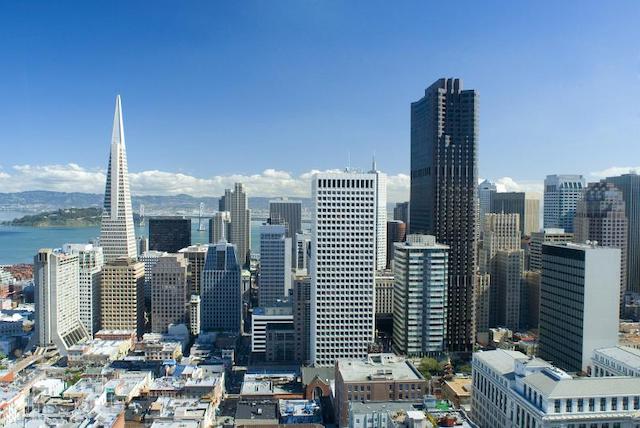Perhaps the Antiplanner is naive, but I’ve always believed that government infrastructure exists to help us be more productive and live the lives we want. To the contrary, I’ve noticed that news reports take it for granted that we exist solely to support the infrastructure that government thinks we should have.
According to the latest estimate, economic activity in downtown San Francisco is only 32 percent of what it was before the pandemic. Photo by PhotoEverywhere.
This is most obvious with urban transit which, since we aren’t riding it, “experts” argue we should pay more taxes to keep it running anyway. Lately, the same attitude is creeping into stories about downtowns.
According to Slate writer Henry Grabar, it’s our duty to either go back to work in downtowns or subsidize the conversion of downtown office buildings into housing and then move in. Otherwise, he warns, the consequences will be dire: office building owners won’t be able to pay their taxes, which could force cities to raise taxes on other people. I don’t find that very persuasive.
Do an image search for “city” and nearly all of the photos will show a downtown filled with skyscrapers that are presumably surrounded by low-rise residential areas. But, as Joel Garreau wrote in Edge City, “We built cities that way for less than a century” and today “they are relics of a time past.”
Garreau exaggerated. In fact, we only really built cities that way for less than half a century. The technology to build skyscrapers wasn’t really available until the invention of high-speed electric elevators in 1891. By the 1920s, low-cost automobiles, electricity, and telephones eliminated all of the reasons to crowd into downtowns. The importance of downtowns declined after that, and from then on people built skyscrapers mainly as ego projects and cities promoted the construction of downtowns like that mainly as echoes of what city leaders had been conditioned to believe a city should look like.
“In the days of electrical transmission, the automobile and the telephone,” wrote Frank Lloyd Wright in 1922, density in the form of skyscrapers “becomes needless congestion — it is a curse.” “There is no city now existing that would be rebuilt as it is, if it were destroyed,” said Henry Ford at about the same time.
Phoenix, the nation’s fifth-largest city, doesn’t have a downtown like that. Neither does San Antonio, the nation’s seventh-largest city. Some people fret that Phoenix and San Antonio aren’t real cities because they don’t have a lot of skyscrapers, but if that’s true then ancient Rome, medieval London, and New York City up through the 1870s weren’t real cities either.
After World War II, American cities published a flurry of downtown plans aimed at restoring downtown areas to what planners believed was their rightful prominence. None of these plans could counter the forces of decentralization: mobility and telecommunications. Downtowns did briefly become entertainment centers thanks, in many cases, to the legalization of the sale of beer on the premises where it was made, thus creating the microbrewpub. But COVID reduced the popularity of such places and they don’t need to be in downtowns anyway.
Triumph of the City, a book released in 2011 by Harvard urban economist Edward Glaeser, argued that dense downtowns were still valuable as places where people could meet face to face. Glaeser himself grew up in a Manhattan high rise, but at the time he wrote his book he was living in rural Massachusetts. Somehow, daily face-to-face meetings weren’t important for his career, but he thought they important for everyone else’s.
The pandemic killed that. Zoom and its kindred might not be as good as face-to-face meetings, but how often do we really have to meet face to face? Except for cars and houses, we don’t have to shop in person anymore (and some people don’t even do so for cars and houses). Most trading in our great financial centers is done electronically. The need for dense downtown areas is pretty much gone.
So don’t feel bad for the downtown property owners who are going to lose money if we don’t return to work in downtown offices. Anyone making an investment knows they are taking a risk and some risks pay off and others don’t. Don’t worry about the loss of property taxes; that could easily be at least partially offset by ending the subsidies we give to downtowns, including subsidized transit systems that mainly serve downtowns. Worry instead about the taxpayers who will have to pay to support ridiculous schemes aimed at “saving” downtowns.









Meanwhile 2,000 Amazon will assemble to protest returning to office, against wishes at work from home. Pandemic scare?
So 2000 people can conglomerate together breathe, cough, sneeze on another….. in parking lot. But not in an office….. you can’t make that shit up
just curious…ther eused to be mill towns in NC many decades back. corporate owned houses for their employees. is there a potential for taller city structures to do the same? work and live buildings, iow? bio lab on 3 floors, housing on teh upper 12 floors, etc?
i am very glad to see that the antiplanner couldn’t really call it quits. if anything, maybe the quantity of posts has gone up?
i enjoyed the quality of this one too. we are on the cusp of what may be a very interesting time for cities as we currently know them.
the frank lloyd wright quote is going to send me off to the library …